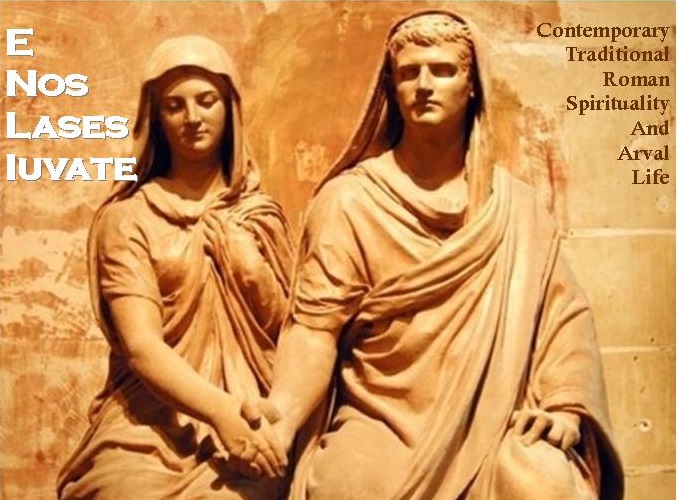December derives its name from the
fact to be the 10th month of the king Numa's ancient calendar which
begins on March.
December represents the "depth", the origins, the Antique and Primordial Time: the
beginning of Time. This is a very particular month focused essentially
on the festivities and rites of Saturnalia and Divalia (dec. 21st). If
Janus represents the beginning, Saturnus (to which December is
dedicated) represents the "end".
During December Nature turns her energies back to Earth: a cycle
ends as precondition for the opening of the next one. This is a period
of Death, not in a profane sense, praparing a re-generation time. The Ianua Coeli open in December.
Main festivities are:
- 1 december - Bona Dea
- 5 december - Faunalia
- 10 december - Janus' Agonalia
- 15 december- Consualia
- 17 december- Opalia
- 18 - 22 december- Saturnalia
- 21 december- Divalia
- 25 december- Sol Invictus

As already mentioned, the entire month
of December is completely inspired by Saturn, an extremely complex
Divine Force. According to Macrobius, great mysteries were hidden in the
Saturnalia rites.
Saturn is a titanic divine force deriving from the union between the Sky
and the Earth in symbolic, hermetic and esoteric meanings.
In this meaning (and only in this not-profane meaning) Saturn is "the Ancient", he symbolizes a primordial state, the Saturnia Regna - the Golden Age/Satya-yuga - the beginning of the Sacred Time. With Saturn, the vital energy of the Earth ceases to be linked to Chaos.
Saturn is evirated (separation from power) and chased away by
Jupiter. For this reason Saturn hid himeself in Latium and then he
disappeared from the Earth. With Jupiter the Age of Silver begins
followed by the Age of Bronze and Iron.
Saturn is at the base of the Roman Tradictional doctrine of the
"Cycles": he represents the Cyclical Death presupposing the beginning of
a new cycle. Being hidden in Latium, the Traditional Roman Religion
directly derives from the primordial traditional wisdom and knowledge of
the Golden Age.
Saturn is the guardian of the secrets of Agriculture (Sator - he cultivating) and navigation (in esoteric sense): he is a Divine Force connected to the "Depth", the Underworld.
All the altars are sacred to Saturn. The ara in the past was just an ara graminacea or a clod of grass and Saturn represents also the primordial fire. During the Saturnalia candles were lit dedicated to the Superior Saturnali to be placed upon the altars.
According to a hermetic perspective, Saturn is symbolized by Lead (Reverse Gold)
as expression of the "Matter". Lead and Gold are both generated by the
same Force of Saturn. He brings a sickle as symbol of Dissolution and a
compasses as symbol of Coagulation.
From Saturn the spyral initiation process begins: for this reason it is
considered the most important step because representing the "primordial
matter" without any form of derivation.
This explains the sentence: "find the hidden Gold in Saturn". This may explain also the reason why the treasury of the Roman State was placed in the Temple of Saturn.
Orphic Hymn to Kronos/Saturn (offering incense)
Etherial
father, mighty Titan, hear,
Great fire of
Gods and men, whom all revere:
Endu'd with various council, pure and strong,
To whom perfection and decrease belong.
Consum'd by thee all forms that hourly die,
By thee restor'd, their former place supply;
The world immense in everlasting chains,
Strong and ineffable thy pow'r contains
Father of vast eternity, divine,
O mighty Saturn, various speech is thine:
Blossom of earth and of the starry skies,
Husband of Rhea, and Prometheus wife.
Obstetric
Nature, venerable root,
From which the various forms of being shoot;
No parts peculiar can thy pow'r enclose,
Diffus'd thro' all, from which the world arose,
O, best of beings, of a subtle mind,
Propitious hear to holy pray'rs inclin'd;
The sacred rites benevolent attend,
And grant a blameless life, a blessed end.
Porphiry, in Perì Agalmàton, writes
that Saturn shows a lazy, slow and cold force: for this reason he is
linked to the Force of Time. He is represented standing up and white
haired to highlight that Time brings the Old Age.
Saturn is placed, in the circular
disposition of the "Peripheral Stripe" by Nigidius Figulus, the 14th
house in the last quarter of the Dii Dextri between West and North.
Jamblicus, in the "On the Egyptian Mysteries",
describes Saturn as a condensation force linked to solidification and
cold. Saturn is an emanation which can be both beneficial and harmful
because it brings rigidity. According to the Tradition, Saturn may cause
laziness, physical deformities and abnormalities, deviousness in
thoughts, anger.
Saturn
Color: Black
Planet: Saturn
Metal: Lead
Status: cold - dry
Number: 6
Musical Note: E
Female Polarity: Mater Larum
Symbol: the Sickle
Arval Implications
Saturn, being a Divine Force at the base
of Agriculture, is for this reason a God bringing Civilization. He is
at the base of the Art of Agriculture, inspires the Relations with the
Earth and how cultivating fields as principle of Civilization for a
Society.
This explains why in this period of the
year dedicated to Saturn we find and feel the presence of important
agricultural Forces such as Consus and Ops. In this period of the year
we must be prepared for the future harvests sacralizing the "neverending
nourishment" of Ops (Abundance).







